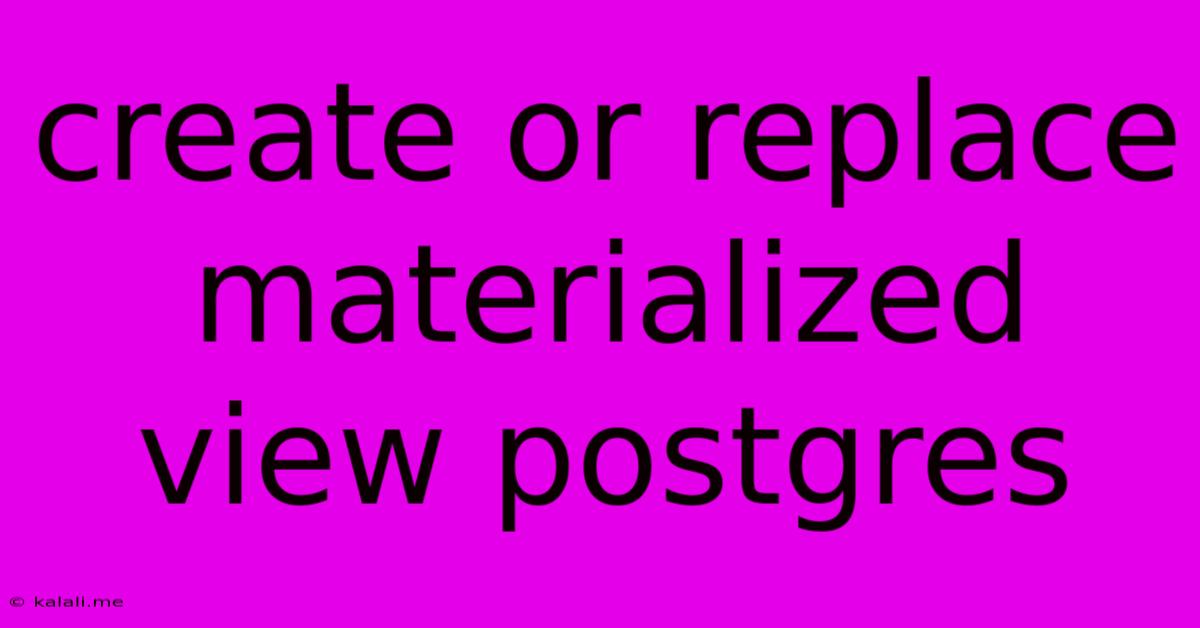Create Or Replace Materialized View Postgres
Kalali
Jun 07, 2025 · 3 min read

Table of Contents
Create or Replace Materialized View PostgreSQL: A Comprehensive Guide
Materialized views in PostgreSQL offer a powerful way to optimize query performance by pre-computing the results of complex queries and storing them in a separate table. This guide will walk you through the CREATE OR REPLACE MATERIALIZED VIEW command, explaining its functionality, benefits, and best practices. This is especially useful for frequently accessed read-heavy queries that might otherwise strain your database. Understanding how to efficiently use materialized views can significantly improve your application's speed and responsiveness.
What is a Materialized View?
A materialized view is essentially a cached result set of a query. Instead of executing the query every time it's needed, PostgreSQL retrieves the data from the materialized view, resulting in significantly faster query times. However, this speed comes at the cost of data consistency; the materialized view needs to be refreshed periodically to reflect changes in the underlying base tables.
The CREATE OR REPLACE MATERIALIZED VIEW Command
The core command for creating and updating materialized views is CREATE OR REPLACE MATERIALIZED VIEW. This command offers several advantages:
- Creation: If the materialized view doesn't exist, it's created.
- Replacement: If the materialized view already exists, it's dropped and recreated. This is particularly useful when you need to update the underlying query or schema. This avoids the need for separate
DROPandCREATEstatements. - Simplicity: It streamlines the process of managing materialized views, making maintenance easier.
Syntax:
The basic syntax is as follows:
CREATE OR REPLACE MATERIALIZED VIEW view_name AS
SELECT query;
Replace view_name with the desired name for your materialized view, and SELECT query with the SQL query whose results you want to materialize.
Example:
Let's say you have a table called orders with columns order_id, customer_id, order_date, and total_amount. You want to create a materialized view showing the total sales per customer:
CREATE OR REPLACE MATERIALIZED VIEW customer_total_sales AS
SELECT customer_id, SUM(total_amount) AS total_sales
FROM orders
GROUP BY customer_id;
This creates a materialized view named customer_total_sales containing the customer ID and their total sales.
Refreshing Materialized Views
Because materialized views are essentially cached data, they need to be refreshed to reflect changes in the underlying tables. PostgreSQL offers several ways to refresh materialized views:
- Manual Refresh: Use the
REFRESH MATERIALIZED VIEWcommand. This is suitable for less frequently updated views. - Automatic Refresh: You can configure PostgreSQL to automatically refresh materialized views at specified intervals using triggers or scheduled tasks. This is best for views requiring frequent updates.
Example of Manual Refresh:
REFRESH MATERIALIZED VIEW customer_total_sales;
Choosing the Right Refresh Method:
The best refresh method depends on several factors, including:
- Frequency of Updates: How often are the underlying tables updated?
- Data Volume: How large are the tables involved?
- Performance Requirements: How critical is the performance of queries against the materialized view?
For tables with frequent updates and large data volumes, automatic refresh might be preferable, potentially using a scheduled task or a trigger. For less frequently updated tables, manual refresh might suffice.
Benefits of Using Materialized Views:
- Improved Query Performance: Significantly faster query execution for frequently accessed read-heavy queries.
- Reduced Database Load: Reduces the load on the database server by pre-computing results.
- Simplified Queries: Materialized views can simplify complex queries, making them easier to understand and maintain.
Considerations:
- Data Consistency: Materialized views are not always up-to-date, so consider the trade-off between performance and data freshness.
- Storage Overhead: Materialized views consume additional storage space.
- Maintenance Overhead: Refreshing materialized views requires additional resources and planning.
Conclusion:
CREATE OR REPLACE MATERIALIZED VIEW is a powerful tool in PostgreSQL for optimizing query performance. By understanding its functionality, benefits, and limitations, you can effectively leverage materialized views to improve the speed and responsiveness of your applications. Remember to carefully consider the refresh strategy based on your specific needs and data characteristics. Proper planning and implementation are crucial to successfully utilize this feature.
Latest Posts
Latest Posts
-
Error Could Not Find Or Load Main Class User Jvm Args Txt
Jun 07, 2025
-
Walking Dead What Does Jss Mean
Jun 07, 2025
-
Light Fixtures Before And After Dim And Light
Jun 07, 2025
-
Can You Brine With Iodized Salt
Jun 07, 2025
-
How To Deposit A Business Check Into A Personal Account
Jun 07, 2025
Related Post
Thank you for visiting our website which covers about Create Or Replace Materialized View Postgres . We hope the information provided has been useful to you. Feel free to contact us if you have any questions or need further assistance. See you next time and don't miss to bookmark.